The Terry Campese story starts with Todd Carney, there’s just no way around it and before Todd Carney was anything else he was Canberra’s chosen one.
Except for Mal Meninga, Canberra’s biggest stars always came from within and Carney was supposed to be like Stuart and Daley and Clyde, he was supposed to be the driving force in making those days come again.
Carney debuted for Canberra days after his 18th birthday in 2004, by 2006 he was the club’s most exciting attacking player and come 2008 he was the subject of a bidding war and earmarked as a future rep star.
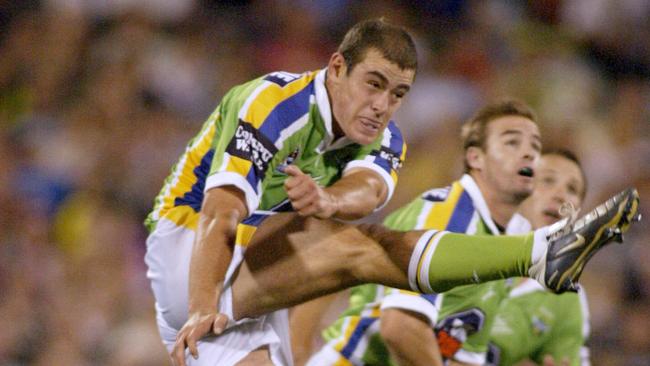
When the Raiders re-signed him in March of that season after months of rumours he was signed, sealed and delivered to Penrith it was a cause for celebration. Canberra weren’t just keeping one of their own, but this was the one, the man through whom all things became possible.
They spoke about Carney like his ascension wasn’t just assumed, but destined, and he could take the rest of the club with him.
Campese re-signed that year as well, but only after the club told him he’d be surplus to requirements in 2009 as Canberra chased Trent Barrett. It was typical of Campese’s career to that point — he’d also debuted in 2004 but managed just 21 games in four seasons and in 2006, when Carney was leading a rollicking charge to the finals, he wasn’t even in Canberra’s top squad.
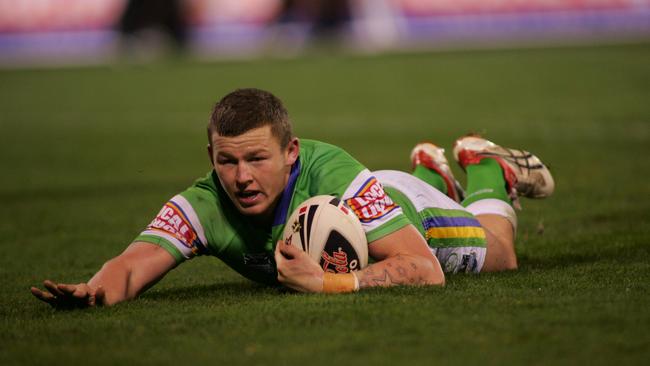
Eventually he did agree to stay once the Barrett chase cooled but like he had for his whole career to that point, Campese was just hanging on. He’d been a junior star like Carney, in both rugby codes as well, but things never seemed to happen for him at the top.
Campese’s first chance at consistent footy had only come once Carney was stood down for a driving offence in 2007.
“There was a period where I won four man of the match awards in five or six games, Toddy came back and I got dropped again,” Campese remembers.
“I was pretty devo. So I put in over the off-season and thought back to when I’d played some good footy.
“I knew I had it in me. I always had confidence.”

For the first half of 2008 the Raiders weren’t that good and they weren’t that bad. In typical Canberra fashion, they were stuck between the spoon and the finals, rarely threatening to break out or break down.
After 13 rounds they were 12th on the ladder and seemingly destined for the mid-table malaise that has dogged the club so many times since the glorious late 80s and early 90s.
Coach Neil Henry had already agreed to join the Cowboys for 2009. Key players like Phil Graham, William Zillman and Lincoln Withers all suffered season-ending injuries early. Carney emerged as the club’s best player while Campese kept hanging on and after the winding path he’d taken to first grade that was enough.
“I knew I had it in me. I always had confidence.”
Everything changed — for Campese, Carney and the club — after Round 14. Canberra ripped off big wins against the Broncos and Bulldogs before upset victories over the Dragons and Roosters, both of whom were in the top four.
The victory over the Chooks, in the wet at Canberra Stadium, was the best performance Carney and Campese ever put together as a duo as they totally outshone the Tricolours Origin pairing of Braith Anasta and Mitchell Pearce.
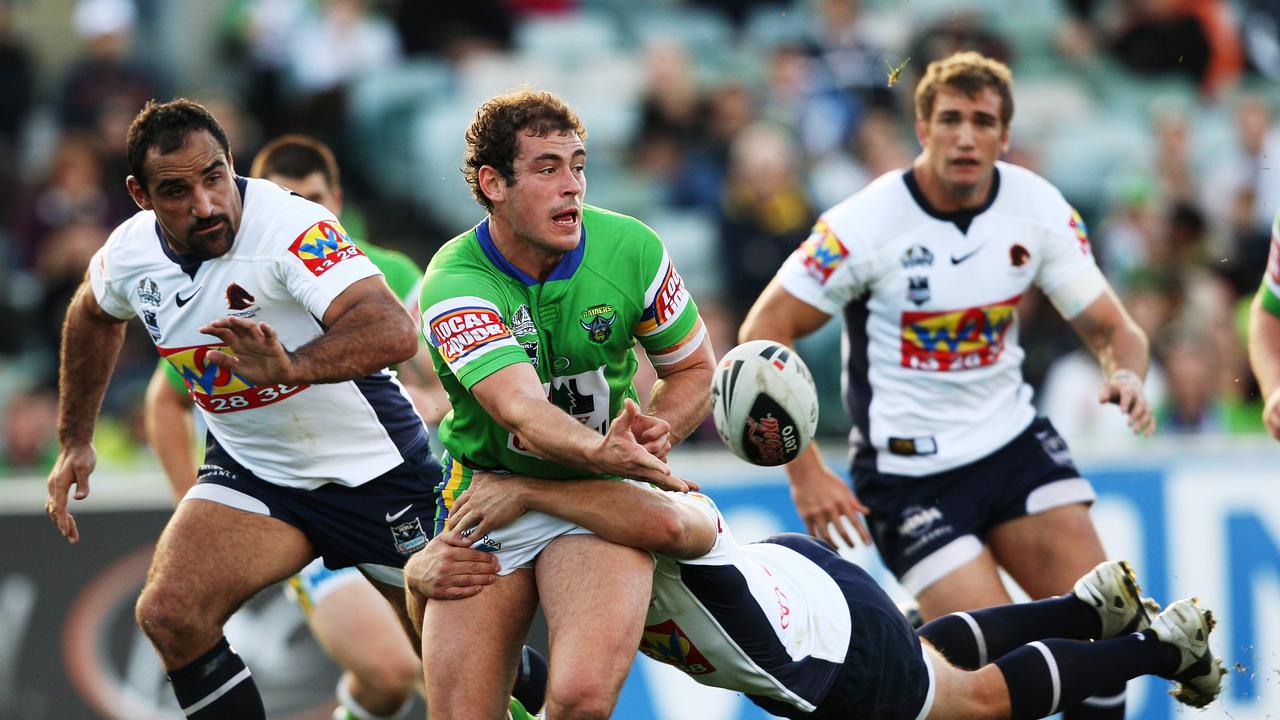
The 34-12 belting was a sign of everything Canberra could be with the two local boys calling the shots, the kind of win that keeps fans believing for years. It was everything the Raiders fans had ever wanted from Campese and Carney and promised a glorious future, not just in 2008 but in the years to come.
Carney never played for the Raiders again.
An incident in a Canberra nightclub led to him being stood down and eventually his contract being torn up and the most talented junior the club had produced in 20 years was gone. The fans were bitter about how it went down — and many are bitter still — but for the players it was just sad.
“Toddy was a good mate. It was more disappointment that we were losing such a quality player and a good mate,” Campese said.
Canberra were sitting in ninth with seven weeks remaining in the season with the expectation they’d lay down and die. After all the injuries and the coaching drama and the Carney saga what else could be expected?
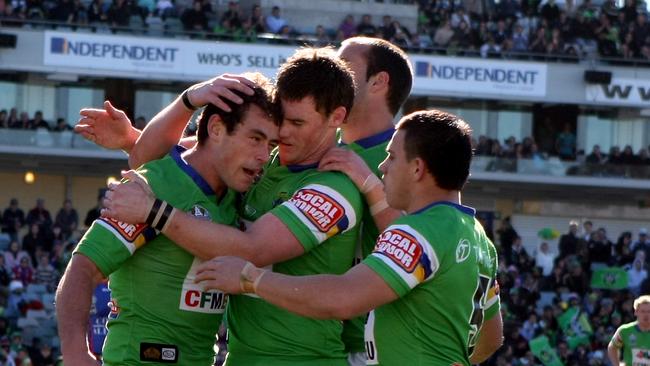
This was an aggressively Canberran team, filled with players who were bizarrely singular to the point where it was impossible to think of them succeeding at any other club.
Who else but Canberra would have a fullback like David Milne, who could run like the wind but only in straight lines because he had the turning circle of a small oil tanker?
Or forwards like Josh Miller and Trevor Thurling, twin blocks of cement taught to play footy, and Dane Tilse, the tallest man in the NRL who was half human, half lumbering golem, or Scott Logan, a barrel-chested hitman who lived to squash his opponents?
Or backs like Adrian Purtell, a centre or winger who never really got the wheels turning and survived on guile, smarts and intuition, and Justin Carney, a funhouse mirror of a man who was as wide as he was tall and had muscles in places other people didn’t have places?
Even Campese, who the club had considered punting only months before, was in a weird spot. Now he was the main man, the don of this band of misfits, and according to the man himself it wasn’t daunting, but liberating.
“Seeing the numbers dwindle in the halves it was kind of like — there’s not many other options, so if I don’t do something then no-one will.

“And it was knowing that pretty much no matter what happened on the footy field I would be there next week, when normally I was stressing. ‘If I don’t play well here Dobbo (Michael Dobson) is back, Toddy’s back, Lincoln Withers is here, Jason Smith, all these other players.
“But in that position I knew (I’d keep playing), cause there were no more numbers.
“If you tried something early and it didn’t come off you weren’t worried about it.
“Usually if I did something wrong or missed a tackle it would play on my mind — ‘ah shit, they’ll see that on the video and I’ll probably lose my spot next week’
“But not having the numbers there, no matter what you did you knew you’d be there next week.
There’s not many other options, so if I don’t do something then no-one will.
“We were a young team and we had our opportunity. There were a lot of guys in a similar position to me, in and out of first grade.”
Canberra made Carney’s sacking official on July 26th, the same day the club were to play the Titans in their first game without him. Rookie Marc Herbert was in at halfback. Campese, running the show for the first time, set up four tries in the best game of his first grade career to that point and led the Raiders to a 46-4 victory.
A sobering 34-6 smashing by Brisbane the next week seemed to take the air out of the tyres. Perhaps the Titans win was just the bounce of the season hitting rock bottom? The following match, a home game against fellow top eight aspirants Penrith, would reveal much of what the 2008 Raiders were about.
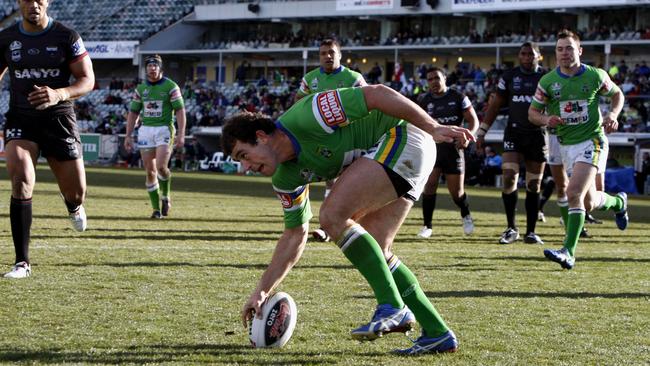
Things were tight early as Penrith went in via Rhys Wesser and Michael Gordon but then the most remarkable afternoon of Terry Campese’s life unfolded, 80 minutes of history that Campese reckons will be talked about “until the day I die”.
The hallmark of the 2008 Raiders was points, laughable, ridiculous, gargantuan amounts of points and never did things crest like it did against the Panthers. By the time the dust settled the Green Machine had cranked out a 74-12 win that made all kinds of history.
It was the equal-third highest score any team had achieved in first grade and just the ninth time a team scored more than 70 points in a match.
Thurling, who, like Campese, hails from Queanbeyan and scored 13 tries in a 100 game-NRL career, crossed for three that day and according to Campese he brings it up to this day after a couple of beers.

The Raiders scored 13 tries in total. Campese set up two and scored four of them, to go with 10 goals for 36 points. Only Mal Meninga and Dave Brown, two Immortals, have ever scored more.
It’s a performance which instantly became legendary, thanks in no small part to the outrageous SuperCoach score it produced (Tim Williams estimates under current rules it would have been around 262, easily the best ever) and it could have been even bigger.
“It’s pretty hard to only play that few games and equal a legend of the club’s tally.
After Tom Learoyd-Lahrs crashed over in the final minutes to stretch the score to 72-12, skipper Alan Tongue decided Herbert, playing just his third first grade game, should take the kick. Nobody on the field knew Campese had the chance to level Meninga’s club record of 38 points in a game but it’s not something Campese regrets.
“It’s pretty hard to only play that few games and equal a legend of the club’s tally.
“It probably gets more publicity now that I didn’t kick it than it would if I did.
“We were just a bunch of young guys having fun and throwing the ball around.
“We were playing attacking footy in our own half, there were stats being thrown around that we were the highest tryscorers (of the season) from our own half.
“It was fun to be a part of it.”
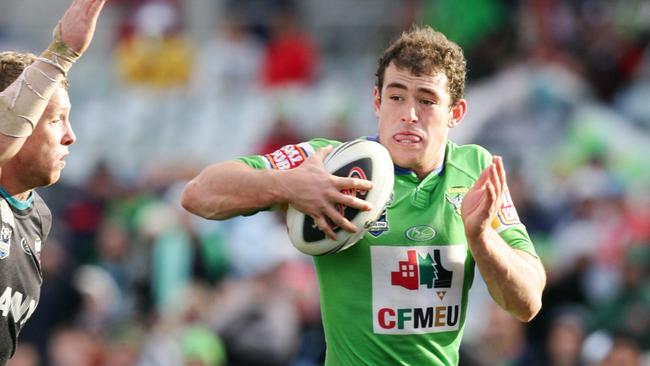
It was from there Canberra really got a fire going. The Penrith win took them from 10th to sixth on the ladder in one fell swoop and their season changed.
It was run and shoot football, attack at all times and let defending take a back seat, the kind of footy that captures the imagination and Campese was at the heart of it all.
Each week the club’s confidence surged and each week Campese grew more assured as the on-field general. Big for a five-eighth, Campese’s skill with ball in hand and ability to take the line on made him a nightmare for opposition defenders and his kicking game, both long and short, was judicious and clever.
Milne thrived in the new world and excelled at hitting holes running off Campese’s hip. After Round 14 he scored 11 tries, broke 67 tackles and made 14 line breaks. He and the other outside backs — Purtell, Carney, Joel Monaghan and Colin Best — feasted on the early ball Campese fed them.
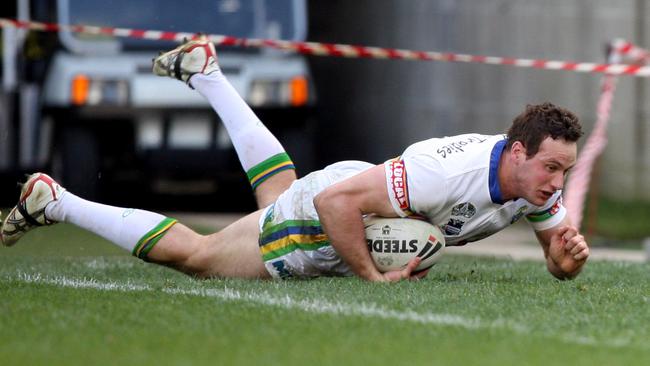
Best’s metamorphosis was typical of the magic that overtook the entire squad. A capable and professional finisher for Cronulla, St George Illawarra and Hull FC, Best transformed over the latter half of 2008 into a scorching, relentless tryscoring artist.
From Round 14 onwards he scored 11 tries, made 18 line breaks and broke 80 tackles. There was a game against the Dragons where he made Mark Gasnier, then counted as the best centre in the world, look second rate and another against Canterbury where he scored four tries.
All the guys who’d been in front of him were somewhere else now, and the Raiders belonged to him.
There were points everywhere, tries for everyone, no lead was ever too big and no deficit ever too large to run down. After Penrith came Newcastle and the 38-18 win felt muted compared to what had come the week before. Campese set up three tries and scored another, but how can the sequel match the first blockbuster?
Then Souths were up and they led the Green Machine 19-6 at halftime but it didn’t matter because by the end it was 40-25 to Canberra. Campese set up three tries in the second half to engineer the comeback.

By this time the Raiders were on the verge of the top four and the punters were behind them in the way they can only be behind a winning team. After the fanbase was so wounded by Carney’s departure, Campese gave them something to believe in again. All the guys who’d been in front of him were somewhere else now, and the Raiders belonged to him.
“The support was enormous. Everyone gets behind you, everyone wants to talk footy in the streets,” Campese said.
“It’s one of those things you enjoy about the game we play. Everyone wants to barrack for you, everyone’s talking footy.
“To see the smile on everyone’s faces, bringing the community together, that’s the biggest positive of it all.
“There’s a big rivalry between league and union (but when the Raiders win) nobody wants to talk about the Brumbies. Everyone’s a Raiders fan.”
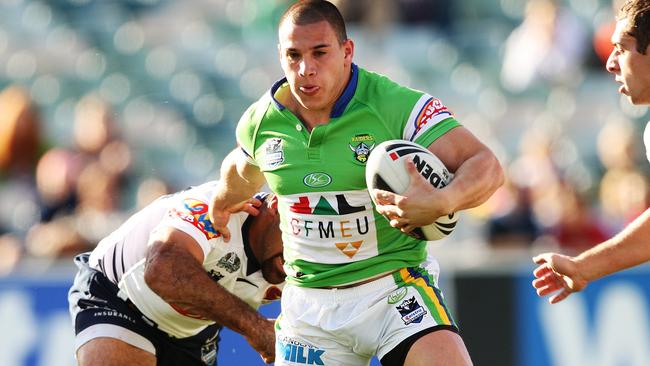
The only thing that was stopping Canberra was injuries, which kept happening as the run went on. After the win over the Knights they lost Learoyd-Lahrs and Justin Carney, then Herbert and Troy Thompson were gone after the South Sydney win. Zillman, Withers, Graham, Michael Weyman and Glen Turner were already down.
But new guys kept turning up and taking their place in the league’s most exhilarating scoring machine. That was until Campese himself got hit with a hamstring injury ahead of the Round 25 clash with North Queensland.
He probably shouldn’t have played but did, because there was no other choice. Tongue played halfback and did all the kicking. In a measure of the player Campese had become, without him at full fitness they crashed to a 22-10 loss to a truly awful Cowboys side who had lost 16 of their last 17.

Regular programming was restored in the final round, a breezy, 52-34 shootout with the Bulldogs which locked up sixth spot. A finals clash with Cronulla awaited and the Sharks, coached by once and future Raider Ricky Stuart, were in the midst of forging the hard-nosed, battle-hardened reputation they still enjoy today.
It was on a brisk night at Shark Park everything began to unravel and it was clear from the first minute this was not Canberra’s night, the magic could only take them so far.
“I don’t think I ever went into any game thinking we were going to lose. Confidence was up,” said Campese.
“First minute of the game we had an opportunity where they threw a big cut out pass and Adrian Purtell could have intercepted it.
“You think back if he caught that and scored we could have gone onto win. You never know.”
Purtell, an intercept specialist with excellent hands, put down the chance and from there it was all Cronulla’s night. Canberra’s free-flowing style blew up in their faces as they made 18 errors. Glenn Buttriss, a rookie dummy half, was thrown in at halfback.

Against his former club and in his final game as a Raider, Best had an absolute shocker and his opposite number, the unheralded Misi Taulapapa, had a hat-trick by halftime.
Once a Best try off a Campese ball was disallowed due to a dubious forward pass call it was clear things would not break for Canberra and they went down 36-10.
The Sharks came in well-prepared and went right after Campese, who made an equal-team high 31 tackles. By this point he’d not just replaced Carney as the club’s best player but as their beating heart.
“It’s always hard when the other team comes up with a good game plan to get at you and sap your energy.
“I think Gal (Paul Gallen) was in the paper in the lead up to the game putting a target on my head. It was unfamiliar territory for me cause it was my first year in first grade so I didn’t usually get targeted before that.
“It was something I enjoyed after that when the challenge came, but it was a first.”
Stuart confirmed the plan after the match.

“You always look at targeting the best players in attack — whether you’re attacking them or defending on them” he said after the match.
“That’s what happens to the good players.”
The good players. That’s who Campese, barely a first grader to begin the year, had become.
The vagaries of the McIntrye system meant Canberra would survive the following week so long as Melbourne, the dominant minor premiers, dispatched the eighth placed Warriors the following day.
New Zealand pulled off one of the great upsets of the NRL era, an 18-15 triumph at Olympic Park that wrenched Canberra’s fate out of their hands and ended one of the most remarkable seasons in the club’s history.
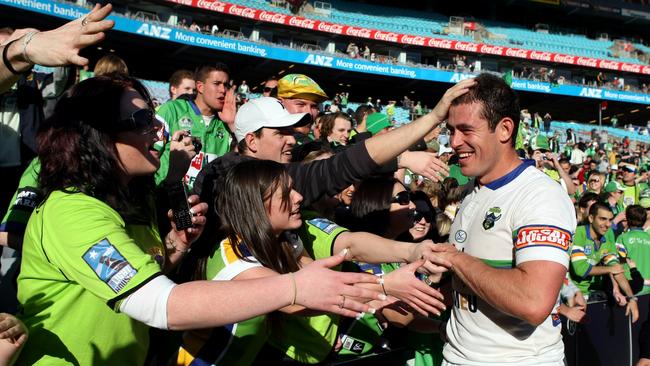
“We thought we’d be playing the next week cause everyone thought Melbourne were going to win,” Campese said.
“But then our chat started going off — ‘can anyone believes this? Can anyone believe what they’re seeing?’.
“Then it started to sink in that we were out of the finals and this magic run, one of the best times of your life, had come to an end.”
In Campese’s first 11 games he managed two tries, two try assists, one line break and six line break assists. In the final 14 games of the season Campese scored eight tries, had 19 try assists, 12 line breaks and 21 line break assists. From Round 14 to the end of the regular season, Canberra averaged 34 points per game. For the final seven games of the season after Carney got sacked it jumped to 38 points per game.
Even with the cue in the rack the wonders kept coming. He was ludicrously overlooked for five-eighth of the year at the Dally M’s but finished just three votes shy of the overall medal.
Best won winger of the year and Henry claimed coach of the year. Then, to cap a remarkable season, Campese was selected alongside good mate Monaghan in Australia’s World Cup squad.
“There was a lot of talk around it (the Dally M). My first half of the season wasn’t the best, so I knew it was going to be a long shot.
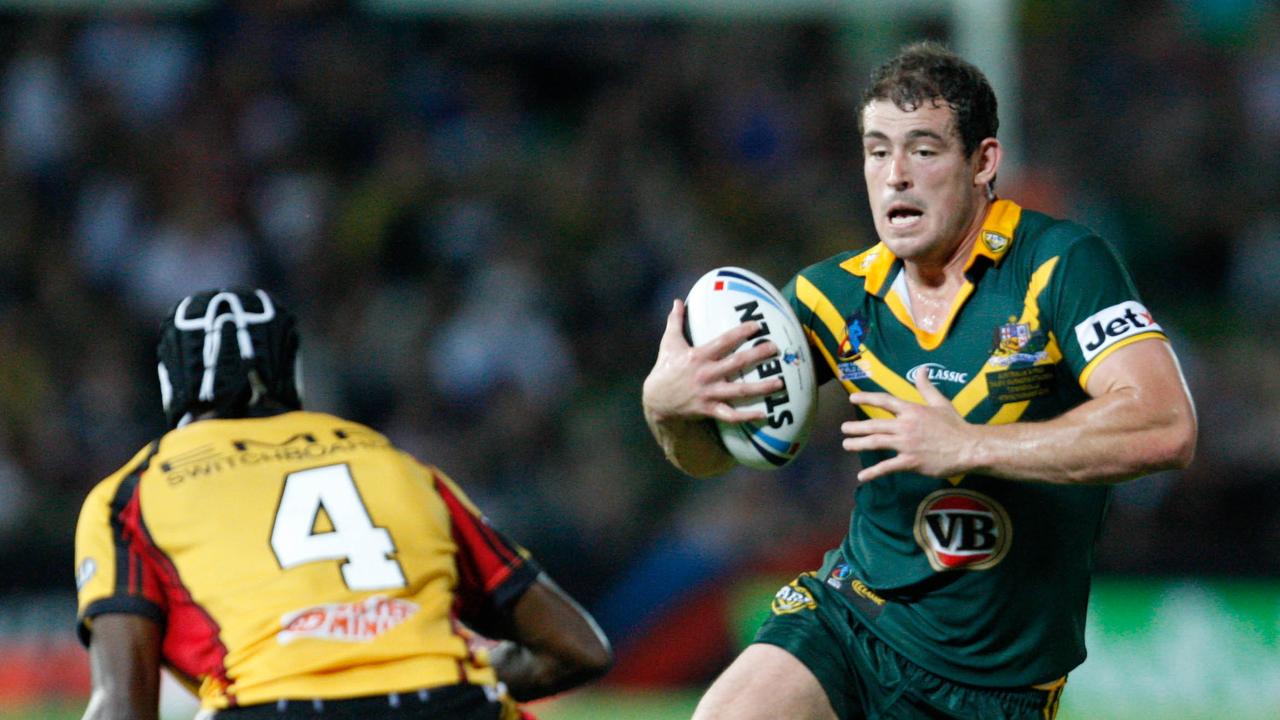
“But I was pretty lucky to finish where I did.
“To say I would have had the year I did and get the representative honours that came out of that 2008 season, I would have laughed if you told me.
“When I found out I was in the car with Joel Monaghan. We got the phone call at the same time, that’s a memorable moment I’ll never forget.
“Looking at each other, high-fiving one of your best mates cause we both made it, it was a proud moment, more so for the family and everyone who put in the hard work to get you there.”
Campese’s Test debut, and his only game for Australia as it turned out, was against Papua New Guinea in Townsville. It was cut short when Neville Costigan, a Canberra teammate, accidentally poked him in the eye. It was a cruel blow and a mark of the truly horrific luck that dogged Campese for much of his career.
In 2009 he made his Origin debut in the series opener and did a passable job but was unfairly dropped and never got another chance in blue. Canberra missed the finals in an inconsistent year but Campese, the new king of the ACT and perhaps the unlikeliest hero the club ever built, signed a five-year contract extension.
But his own admission, Campese never got back to his 2008 form and only got close twice.
“The back end of the year in 2010 I think I was definitely showing some signs like 08.
“In 2010 definitely and probably the only other time was when I was in England and finally got confidence in my knees again.”
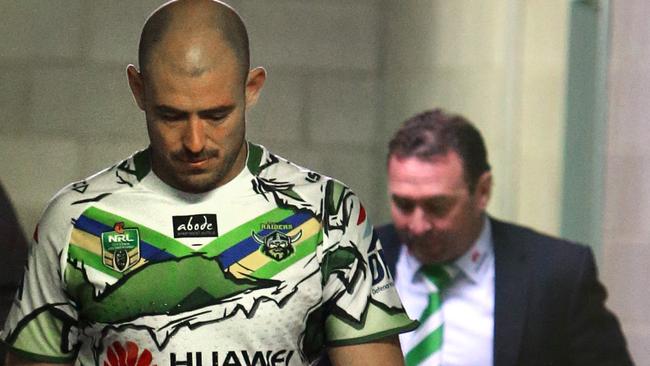
The 2010 Raiders did not burn as bright as their 2008 counterparts but they burned longer and had a real shot at winning the premiership before Campese’s knee gave out in the finals loss to the Tigers.
From there, injuries ruined Campese. He managed one game in 2011 and seven in 2012. By the time he was back on the field permanently in 2013 he was a shell of what he once was, still quick between the ears but robbed of the running game that made him so dangerous due to a series of awful knee injuries.
He wasn’t the only 2008 Raider who couldn’t find it again. Milne only played 13 more NRL games, Best soldiered on for Souths and Cronulla but never touched his ‘08 form and Purtell headed to Penrith at the close of the following season.
Campese was one of the last of those Raiders to leave, departing for Hull KR after the disastrous 2014 season, which he began as club captain but ended in reserve grade.
But he’s not bitter and since returning to Australia he’s remained in and around the ACT, captaining Queanbeyan to a premiership in the local competition. He still sees many of his former teammates around the traps and they trade war stories whenever they meet.
“Down at the pub sometimes people talk about that year and 2010. But the form, for myself and the squad, you’ll probably never see that stuff ever again.

“It’s once in a lifetime. It’s only now that I think back and appreciate it, when I get together with the guys and talk about it.
“We had Josh Papalii’s wedding last weekend and all the boys were there and we still talk about it.
“It’s not until you sit back and you look back at what you achieved, (you remember) the special games, and the special moments.”
Things came full circle at the Legends of League tournament on the Central Coast in mid-November. Campese played for a Barbarians side and Carney was a late call up. The lost combo, the one that was supposed to bring the glory back to Canberra, rising out of time like a mirage for one last tantalising look at what could have been, dodgy knees and hamstrings be damned.
“It was a shock when I saw him announced in the side. I think we’ve spoken more in the last two days then we have in the last ten years,” Campese said.
“I’m excited to catch up and so is he. It definitely brings back a lot of the memories we’re talking about right now.
“We lost a lot of potential — we all saw what he went on to do at the Roosters. It’s one of those things you look back on and wonder what could have been.
“If we were the halves for years after that who knows what could have happened.”
Every Test, ODI & T20I live, ad-break free during play and in 4K. Only on Foxtel. SIGN UP TODAY!

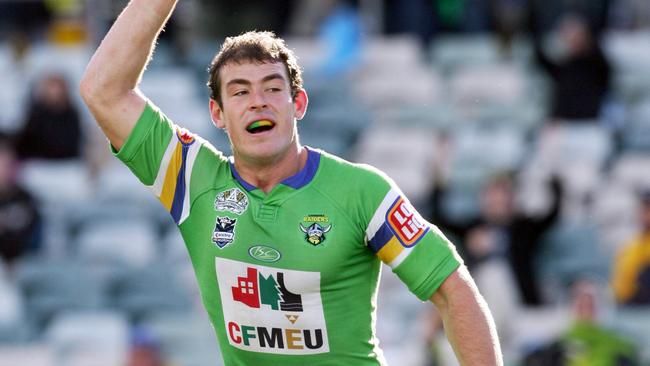
Add your comment to this story
To join the conversation, please log in. Don't have an account? Register
Join the conversation, you are commenting as Logout
NRL June 30 transfer deadline: Every player move, potential destinations
Manly and the Sydney Roosters have been at the centre of the June 30 frenzy, while Wests Tigers young gun Tallyn Da Silva is heading to western Sydney. See every transfer and top-30 promotions.
Maroons No.1 dilemma: Who will replace Ponga in Origin decider
Star fullbacks Reece Walsh and Hamiso Tabuai-Fidow have gone head-to-head in a Super Saturday shootout, as the race to replace Kalyn Ponga for Origin III heats up. Who will win? VOTE in our poll.